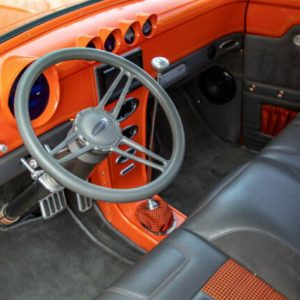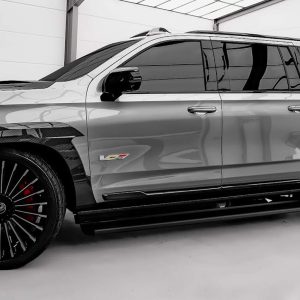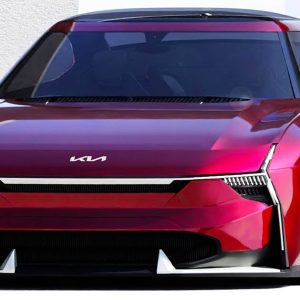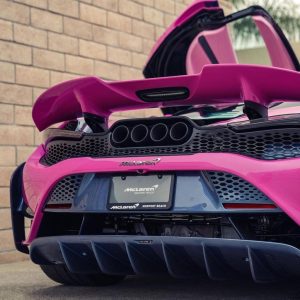
According to Peterson focusing on the heavy-industrial fleet market is all about “keeping it real”.
He says: “We’re not pretending we’re Tesla or Arrival or another EV manufacturer, where we’re just going to build 20,000 [cars] and they’re going to be marketed all over the world. We’re a small team. We’ve got a big ambition, but we’re not overstepping our mark. We’re building a specialist vehicle and we’re really, really listening to our customers and understanding what they need from a vehicle like this.”

What those conversations have manifested is a 4×4 that’s easily mistaken for an old Defender – and borrows many of its fundamentals – but it is significantly more sophisticated in its propulsion.
The Mk1 uses a body-on-frame design with a ladder-style skateboard chassis. The entry-level Utility model is fitted with a single electric motor, yielding 295bhp and 443lb ft of torque. This is delivered to all four wheels via a two-speed gearbox (with a low-range gear and central locking differential), plus locking differentials on each of the rigid-beam axles.
Suspension comes in the form of traditional coil springs and shock absorbers, which help to give the Mk1 an impressive spec sheet: 480mm of ground clearance, a maximum approach angle of 84deg, a departure angle of 51deg and a breakover angle of 32deg. For context, a four-door Jeep Wrangler Rubicon has a 43.9deg approach angle, a 37.0deg departure angle, a 22.5deg breakover angle and 274mm of ground clearance.
But the Mk1’s capabilities don’t matter much if its unproven technology fails in the face of punishment, which will be inevitably meted out to it by commercial drivers. Chief designer Ross Compton says dependability was the priority, as demonstrated by the quad-LED headlight signature in which each individual unit can be replaced cheaply and easily. Every body panel is made from folded aluminium and sheet steel, further cutting cost and complexity.

This philosophy extends to the Mk1’s electricals, with the entry-level Utility model’s 56kWh battery offering a claimed range of between 63.5 miles (when towing a 2500kg braked trailer) and 141 miles (in optimal conditions).
Compton says: “Right now, our range is set quite comfortably [based on customer feedback] and we could increase that potentially by 100 miles, but then that comes with extra weight. If you’re not using that – you’re on the farm and you don’t really need the extra 50, 100, 200 miles – then it’s like: ‘Here you go: here’s a heavy truck for no reason at all.’”
Munro will begin production of the Mk1 later this year, albeit on a limited scale – in line with Peterson’s “keeping it real” philosophy. He sets a target of delivering 50 ‘Founders Edition’ cars over the next 12 to 18 months in a de facto beta test, acknowledging that there may be teething troubles as factory processes are established and the Mk1 begins to accumulate plenty of real-world miles.

This initial run will be built at Munro’s workshop in Glasgow, making it the first Scottish vehicle manufacturer to target a significant volume since Peugeot-Talbot left Linwood in 1981.
This is a point of pride for Peterson, who cites an opportunity to help local business: “When we go out to a supplier and we say we’re going to need X amount of components, they start to think: ‘We might hire someone extra.’ It has a direct impact on the local economy, which is really cool. And everyone sees it: we see it; our suppliers see it; our customers see it.”
Should the Mk1 – and Munro, by extension – prove itself, then eventual global expansion is on the cards. Peterson says: “The likes of Gleneagles quite like the look of it, but then equally we get people ringing up from St Lucia that want one, so commercially and product-wise we’re concentrated on the fleet market because we think that it’s ripe for disruption.”
But to achieve such reach – Peterson floats a rough target of “the low thousands” by the tail end of this decade – the company will have to find a new home, and fast. In the spirit of realism, Munro isn’t looking for grounds on which it can build a bespoke headquarters to fit its production processes.
Instead, it plans to “chunk up” stages of manufacturing into a series of 35,000-square-foot industrial units. The theory is that this will allow the firm to move onto an estate – or a series of local estates – and scale up production in line with its order book.
Peterson summarises the ethos neatly: “The effort has gone into planning the processes and factory assembly, rather than worrying about what the sign looks like on the front of it.
What is the Munro Mk1 like off-road?

Riding shotgun in a late prototype of the Mk1 around the Gleneagles off-road course, it quickly becomes clear that it’s an impressive off-road package. The torque provided by the single-motor powertrain allows it to saunter up steep hills that would have an old Defender wheezing; and on the way back down, the regenerative brakes emulate the hill descent control function from vastly more expensive 4x4s.

There’s also impressive traction through especially slick pools of mud and chest-height fords. No need to worry about trashing the battery in such scenarios, either, because it’s reinforced with inches of metal. Over ruts where a Landie would toss you around in your seat, the Munro remains comfortable, but without completely isolating you from the contours of the surface below.

However, it should be noted that we did not ride in the Mk1 on the road, where meeting the standard set by sophisticated commercial pick-ups such as the Ford Ranger will prove a tough task





